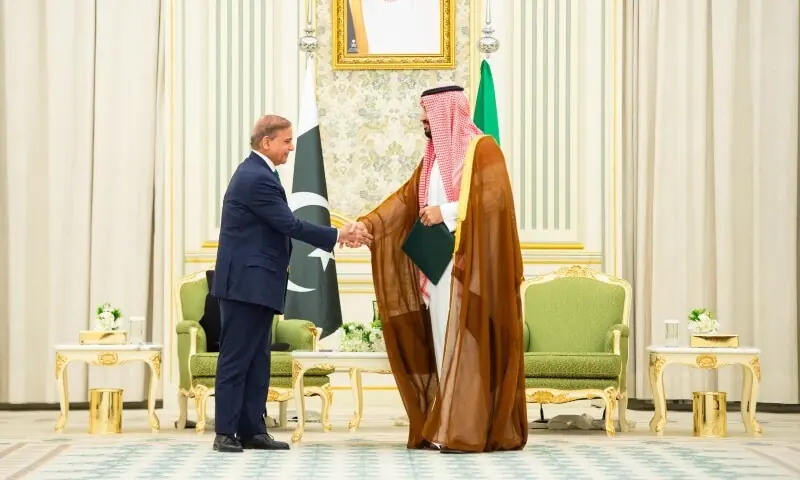By Baqir Sajjad Syed
Copyright dawn

THE signing of a ŌĆśStrategic Mutual Defence AgreementŌĆÖ between Pakistan and Saudi Arabia is being seen as a moment of tectonic significance for the Middle East and South Asia.
On the face of it, it is a declarative pact, containing a commitment to collective defence in the spirit of NatoŌĆÖs Article 5, from where the accord borrows language regarding an attack on one partner being considered aggression against both.
Beneath the surface, however, there is deliberate ambiguity about the scope of this agreement, which implies strategic signalling.
The obvious signal is that Riyadh believes US security guarantees are no longer the sole hedge for its defence, and that it is prepared to institutionalise its own deterrence.
What is public is short and formal. The official statement gave only a brief description, saying the agreement aims ŌĆ£to develop aspects of defence cooperation between the two countries and strengthen joint deterrence against any aggression.ŌĆØ
Riyadh will look to benefit from ŌĆśoperational and symbolic biteŌĆÖ of PakistanŌĆÖs military capabilities
That measured phrasing is a diplomatic curtain, but conversations behind it have been anything but modest. Because the written text is opaque and probably deliberately ambiguous, the debate that followed ŌĆö especially among Western experts ŌĆö focused first and foremost on one explosive possibility ŌĆö does this pact imply a Pakistani nuclear umbrella for Saudi Arabia?
One senior Saudi official, when asked by Western media whether the pact might obligate Pakistan to provide such a guarantee, bluntly said, ŌĆ£This is a comprehensive defensive agreement that encompasses all military means.ŌĆØ
Saudi commentators amplified the implication on television. Political analyst Muneef Al-Harbi said, ŌĆ£All available military means on both sides will be used if neededŌĆ” Nothing is excluded, even deterrent means.ŌĆØ
Those observations fuel speculation about the existence of an itemised nuclear-sharing clause because they show what RiyadhŌĆÖs own media ecosystem and public intellectuals believe the agreement is meant to achieve.
Speculation in western circles notwithstanding, PakistanŌĆÖs position on the nuclear deterrent is very clear; Islamabad was obliged to develop nuclear capability for self-defence and deterrence and it is intended solely for safeguarding the countryŌĆÖs own sovereignty and territorial integrity, not for extension to other states.
Western reaction
Even so, the immediate reaction from Washington likely is likely to be alarm, tempered by a degree of calculation.
As Christopher Clary, a scholar at the Stimson Centre, told Dawn, ŌĆ£The US is not enemies with either Pakistan or Saudi Arabia, but it would likely view any explicit nuclear-sharing arrangement with concern.ŌĆØ
Nuclear sharing and extended deterrence, in his view, are much harder in practice than in theory, so only time will tell what stipulations the pact actually entails. Whatever the eventual reality, the accord has already shifted the political conversation. Ambiguity it seems, is also a form of deterrence.
The Saudi side has also been quite explicit about the more conventional building blocks of the pact.
As Jamal Al-Harbi, the press attach├® at the Saudi embassy in Islamabad, wrote in Arab News: ŌĆ£The newly signed agreement aims to expand military cooperation on multiple levels. Key elements include joint military exercises to improve operational readiness and interoperability, intelligence sharing to counter emerging threats, particularly terrorism and cross-border insurgencies.ŌĆØ
ŌĆ£Additionally, it includes defence industry collaboration, with potential for technology transfer and co-production of military equipment, as well as capacity building and training, building on the longstanding tradition of Pakistani military personnel working with Saudi forces. There is potential for mutually beneficial industrial partnerships in emerging security fields such as cybersecurity, drone technology, and space-based defence systems.ŌĆØ
Put plainly, the pact is not merely a rhetorical shield.
If the partners follow through with joint planning, interoperability standards, intelligence fusion, and defence-industrial links, the result would be the most significant re-architecture of Gulf security since the US basing network was built after 1990.
Whether it becomes an integrated command and operational reality with rotational deployments, pre-negotiated contingency plans, and shared logistics will determine whether this is a heavyweight security alliance or an expensive piece of theater.
Treaty or agreement?
The documentŌĆÖs label ŌĆö an ŌĆ£agreementŌĆØ rather than a ŌĆ£treatyŌĆØ ŌĆö has yielded an argument about legal force.
Ahmer Bilal Soofi, President of the Research Society of International Law, told Dawn that the Vienna Convention provides a simple test: Article 2 defines a treaty as ŌĆ£an international agreement concluded between States in written form and governed by international law ŌĆ” whatever its particular designation.ŌĆØ
By that standard, form and substance matter more than the label. If the parties intend binding commitments and write them down, the instrument acquires the legal character of a treaty regardless of what a headline calls it.
Who does it aim to deter?
Timing explains a lot. The signing followed high-profile Israeli strikes in Doha and comes amid a broader sense in Gulf capitals that the United States may not be the automatic guarantor it once was. RiyadhŌĆÖs public posture is that the pact is not aimed at any single state; privately, the message is unmistakable.
Whatever the primary object of RiyadhŌĆÖs deterrence; be it Tehran, Tel Aviv, or a broader effort to project power into contested theatres, the pact may well reshape the balance of power in the Middle East ŌĆö especially because PakistanŌĆÖs conventional and nuclear capabilities carry symbolic as well as operational bite.
That symbolism cuts both ways. For Islamabad, the pact cements PakistanŌĆÖs claim to be more than a regional player. For Riyadh, it validates a strategy of strategic hedging maintaining American ties while deepening relations with Islamabad, China, and Russia.
To quote Muneef Al-Harbi: ŌĆ£Saudi Arabia doesnŌĆÖt replace one strategic partner with another. It expands its partnerships: with the West, with China, with Russia. Agreement with Pakistan fits this pattern.ŌĆØ
The India problem
The new alignment could also put Riyadh in an awkward position with New Delhi. India has worked steadily to cultivate Riyadh for energy, trade, and diplomatic support and would not welcome an explicit security tether between its principal energy supplier and its strategic rival.
New DelhiŌĆÖs public line on the signing of the agreement is that it will ŌĆ£study the implications.ŌĆØ This captures DelhiŌĆÖs dilemma about how to preserve commercial ties without neglecting a shifting security calculus that may
now require defensive reassessments. ŌĆ£In South Asia, it may heighten IndiaŌĆÖs caution in dealing with Pakistan,ŌĆØ the Saudi embassyŌĆÖs media attach├® warned.
An ŌĆśIslamic NatoŌĆÖ?
This is something which has long been theorised. Past Saudi efforts, like the 2015 Islamic Military Counter Terrorism Coalition, proved more symbolic than operational.
But the latest pact is different precisely because it ties the language of collective defence to concrete cooperation.
Brig Faisal Al-Hamad suggested: ŌĆ£Right now, itŌĆÖs bilateral, but donŌĆÖt forget Saudi Arabia already has a joint defence pact with the GCC. Adding Pakistan makes seven countries. We may soon see this expand. At the very least, itŌĆÖs the strongest step yet toward an Islamic strategic alliance.ŌĆØ
Muneef Al-Harbi went further, arguing that ŌĆ£This pact reshapes regional security ŌĆö it may not stop at just Riyadh and Islamabad. Other countries may join this Saudi-Pakistani track.ŌĆØ
Whether Egypt, Turkey, or others sign on will turn on politics, prestige, and whether capitals prefer loose security webs or binding commitments.
Published in Dawn, September 19th, 2025



